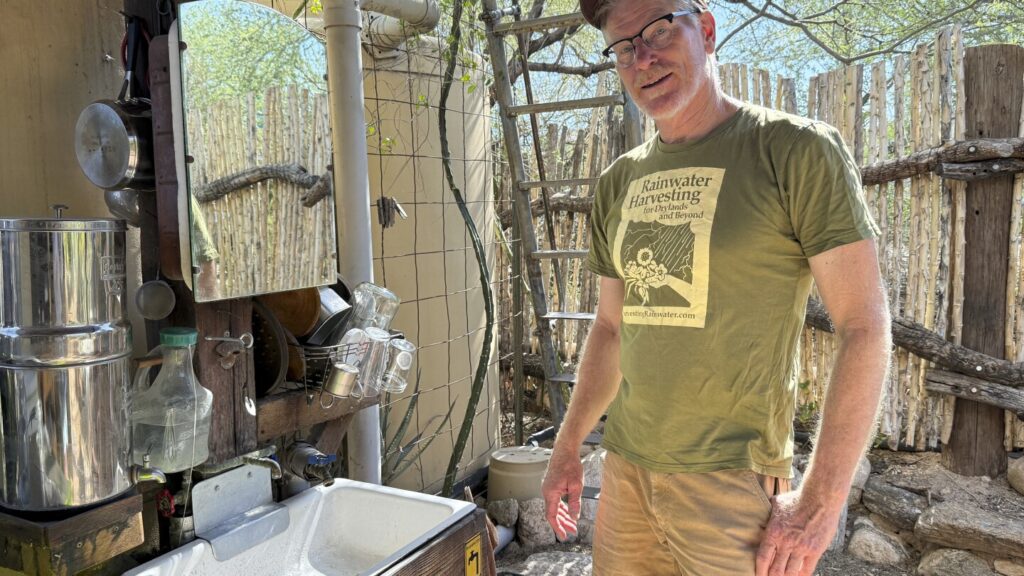TUCSON, Ariz. (AP) — Nothing makes Brad Lancaster happier than a monsoon downpour.
The tall 58-year-old jumped like a kid in the puddles on the sidewalk one recent August afternoon after a half inch (1.3 centimeters) of rain suddenly fell in Tucson, Arizona, during an especially dry summer.
“Sweet!” Lancaster exclaimed, beaming when he saw how the water pooled in a basin he had dug earlier in dirt planted with native vegetation along the public walkway.
“It’s really important that you are ready to plant the rain when it comes, even if it is a small amount,” he said, referring to a simple type of rainwater harvesting that involves digging a hole to allow rainwater to sink underground and be held like a sponge. “The key is to collect every drop of it.”
In the U.S. Southwest and beyond, home gardeners and landscapers are increasingly using collected rainwater to nourish their rose bushes and cactus gardens amid worsening drought and rising temperatures fueled by global warming.
Lancaster and other rainwater harvesting specialists say home gardeners anywhere can benefit from collecting raindrops and runoff from buildings and other surfaces to irrigate plants, even in wetter regions where the practice is less common.
Rainwater collecting is widespread in many of Earth’s driest regions. In Australia, it’s often used for drinking water, bathing and flushing toilets. And in Africa — where Lancaster said he learned more about the practice — it helps communities survive.
Saving the rain is also useful in southern Arizona, which is under pressure from a long-running drought. It’s drier than ever, with Tucson receiving less than half of the about 7 inches (18 centimeters) of rain it usually sees by the first week of September.
Some of the heaviest rainfalls in Arizona and other parts of the U.S. Southwest occur in the summer, during the annual North American monsoon season.
As much as two-thirds of residential water in the desert city is used outdoors, said Adriana Zuniga, an associate research professor in environmental policy programs at the University of Arizona.
“The idea is to use less water from the tap to irrigate,” she said.
Rainwater harvesting is by no means a modern revolution.
Zuniga, who has researched water use of the Maya people who lived in what is now Central America and southeastern Mexico, noted that the ancient civilization captured rainwater to survive dry, hot summers.
“It should be fundamental to how we live in the Southwest and ultimately everywhere else in the coming years in the face of climate change,” said Tucson landscaper Eli Nielsen, who co-owns a store that sells rainwater harvesting products including rain chains that guide water from atop buildings.
Looking to create a rain collection system of your own? Here’s how to start:
Educate yourself
Find out if your state has restrictions on rainwater harvesting or requires a permit due to environmental or health and safety considerations. A tool created by the Pacific Northwest National Laboratory in collaboration with the Federal Energy Management Program can help.
See if your city or county water department has a program that encourages rainwater harvesting or has other resources. Your local community college or cooperative extension office may have educational programs offering guidance.
In the case of Tucson, the city water department offers rebates of up to $2,000 for residential rain collection systems. It works with the local nonprofit Watershed Management Group to provide free 2½-hour classes residents must take to design a collection system that qualifies for a rebate.
One class anyone can attend virtually is the Essential Rain Water Course, offered for free on YouTube. It is co-hosted by water harvesting authority Peter Coombes, an honorary professor at the Australian National University and managing director of the independent think tank Urban Water Cycle Solutions, and Michelle Avis, co-founder of the Canadian organization Verge Permaculture.
Many proponents of collecting precipitation say the most authoritative book on the subject is Lancaster’s “Rainwater Harvesting for Drylands and Beyond,” along with a second volume published later. Lancaster also offers free resources to the public on his website.
Make a plan
Decide how ambitious you want to be.
Few people are going to be as dedicated to collecting the rain as Lancaster, said Hsin-I Chang, an assistant research professor in hydrology and atmospheric sciences at the University of Arizona. She gives Lancaster credit for the practice’s popularity in Tucson.
Active harvesting systems use storage tanks, pipes and sometimes pumps. But simpler passive systems are low-tech and work by shaping the landscape with basins and other contouring alongside trees and other foliage. That allows rainwater to gather and then sink underground to recharge aquifers and nourish thirsty plants nearby.
“It’s very easy to get started with contouring,” Chang said, noting that active systems can be more expensive to set up and maintain.
Looking for more help?
If you need assistance, consider hiring a landscaper with experience in harvesting systems. You can also seek out master gardeners at local nurseries or home improvement stores.
And you can look to Lancaster for inspiration, tapping into the joy he expresses every time the rain falls.
___
For more AP gardening stories, go to https://apnews.com/hub/gardening.

